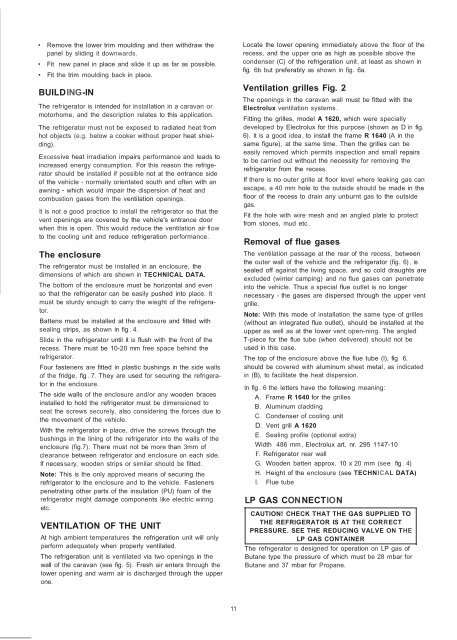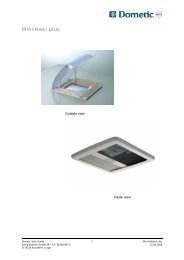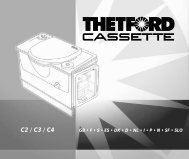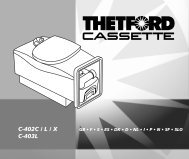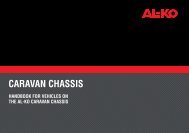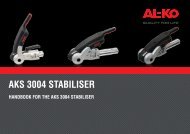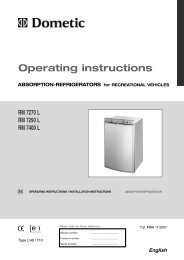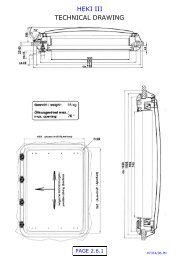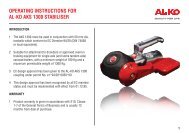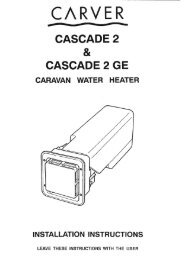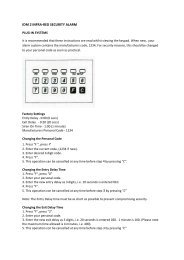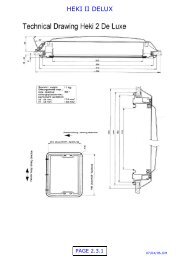RM4270 & RM4271 fridge manual - Swift Owners Club
RM4270 & RM4271 fridge manual - Swift Owners Club
RM4270 & RM4271 fridge manual - Swift Owners Club
You also want an ePaper? Increase the reach of your titles
YUMPU automatically turns print PDFs into web optimized ePapers that Google loves.
• Remove the lower trim moulding and then withdraw the<br />
panel by sliding it downwards.<br />
• Fit new panel in place and slide it up as far as possible.<br />
• Fit the trim moulding back in place.<br />
BUILDING-IN<br />
The refrigerator is intended for installation in a caravan or<br />
motorhome, and the description relates to this application.<br />
The refrigerator must not be exposed to radiated heat from<br />
hot objects (e.g. below a cooker without proper heat shielding).<br />
Excessive heat irradiation impairs performance and leads to<br />
increased energy consumption. For this reason the refrigerator<br />
should be installed if possible not at the entrance side<br />
of the vehicle - normally orientated south and often with an<br />
awning - which would impair the dispersion of heat and<br />
combustion gases from the ventilation openings.<br />
It is not a good practice to install the refrigerator so that the<br />
vent openings are covered by the vehicle's entrance door<br />
when this is open. Thi s would reduce the ventilation air fl ow<br />
to the cooling unit and reduce refrigeration performance.<br />
The enclosure<br />
The refrigerator must be installed in an enclosure, the<br />
dimensions of which are shown in TECHNICAL DATA.<br />
The bottom of the enclosure must be horizontal and even<br />
so that the refrigerator can be easily pushed into place. It<br />
must be sturdy enough to carry the wieght of the refrigerator.<br />
Battens must be installed at the enclosure and fitted with<br />
sealing strips, as shown in fig . 4.<br />
Slide in the refrigerator until it is flush with the front of the<br />
recess. There must be 10-20 mm free space behind the<br />
refrigerator.<br />
Four fasteners are fitted in plastic bushings in the side walls<br />
of the <strong>fridge</strong>, fig . 7. They are used for securing the refrigerator<br />
in the enclosure.<br />
The side walls of the enclosure and/or any wooden braces<br />
installed to hold the refrigerator must be dimensioned to<br />
seat the screws securely, also considering the forces due to<br />
the movement of the vehicle.<br />
With the refrigerator in place, drive the screws through the<br />
bushings in the lining of the refrigerator into the walls of the<br />
enclosure (fig.7). There must not be more than 3mm of<br />
clearance between refrigerator and enclosure on each side.<br />
If necessary, wooden strips or similar should be fitted.<br />
Note: This is the only approved means of securing the<br />
refrigerator to the enclosure and to the vehicle. Fasteners<br />
penetrating other parts of the insulation (PU) foam of the<br />
refrigerator might damage components like electric wiring<br />
etc.<br />
VENTILATION OF THE UNIT<br />
At high ambient temperatures the refrigeration unit will only<br />
perform adequately when properly ventilated.<br />
The refrigeration unit is ventilated via two openings in the<br />
wall of the caravan (see fig. 5). Fresh air enters through the<br />
lower opening and warm air is discharged through the upper<br />
one.<br />
Locate the lower opening immediately above the floor of the<br />
recess, and the upper one as high as possible above the<br />
condenser (C) of the refrigeration unit, at least as shown in<br />
fig. 6b but preferably as shown in fig. 6a.<br />
Ventilation grilles Fig. 2<br />
The openings in the caravan wall must be fitted with the<br />
Electrolux ventilation systems.<br />
Fitting the grilles, model A 1620, which were specially<br />
developed by Electrolux for this purpose (shown as D in fig.<br />
6). It is a good idea, to install the frame R 1640 (A in the<br />
same figure), at the same time. Then the grilles can be<br />
easily removed which permits inspection and small repairs<br />
to be carried out without the necessity for removing the<br />
refrigerator from the recess.<br />
If there is no outer grille at floor level where leaking gas can<br />
escape, a 40 mm hole to the outside should be made in the<br />
floor of the recess to drain any unburnt gas to the outside<br />
gas.<br />
Fit the hole with wire mesh and an angled plate to protect<br />
from stones, mud etc.<br />
Removal of flue gases<br />
The ventilation passage at the rear of the recess, between<br />
the outer wall of the vehicle and the refrigerator (fig. 6) , is<br />
sealed off against the living space, and so cold draughts are<br />
excluded (winter camping) and no flue gases can penetrate<br />
into the vehicle. Thus a special flue outlet is no longer<br />
necessary - the gases are dispersed through the upper vent<br />
grille.<br />
Note: With this mode of installation the same type of grilles<br />
(without an integrated flue outlet), should be installed at the<br />
upper as well as at the lower vent open-ning. The angled<br />
T-piece for the flue tube (when delivered) should not be<br />
used in this case.<br />
The top of the enclosure above the flue tube (I), fig 6,<br />
should be covered with aluminum sheet metal, as indicated<br />
in (B), to facilitate the heat dispersion.<br />
In fig . 6 the letters have the following meaning:<br />
A. Frame R 1640 for the grilles<br />
B. Aluminum cladding<br />
C. Condenser of cooling unit<br />
D. Vent grill A 1620<br />
E. Sealing profile (optional extra)<br />
Width 486 mm , Electrolux art. nr. 295 1147-10<br />
F. Refrigerator rear wall<br />
G. Wooden batten approx. 10 x 20 mm (see fig . 4)<br />
H. Height of the enclosure (see TECHNICAL DATA)<br />
I. Flue tube<br />
LP GAS CON NECTION<br />
CAUTION! CHECK THAT THE GAS SUPPLIED TO<br />
THE REFRIGERATOR IS AT THE CORRECT<br />
PRESSURE. SEE THE REDUCING VALVE ON THE<br />
LP GAS CONTAINER<br />
The refngerator IS designed for operation on LP gas of<br />
Butane type the pressure of which must be 28 mbar for<br />
Butane and 37 mbar for Propane.<br />
11


